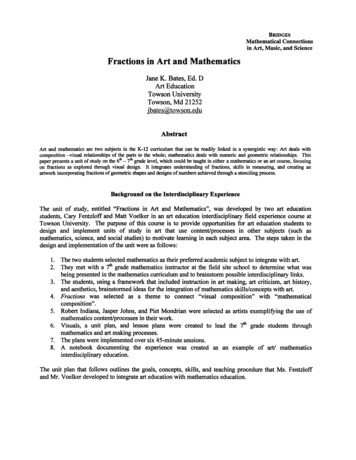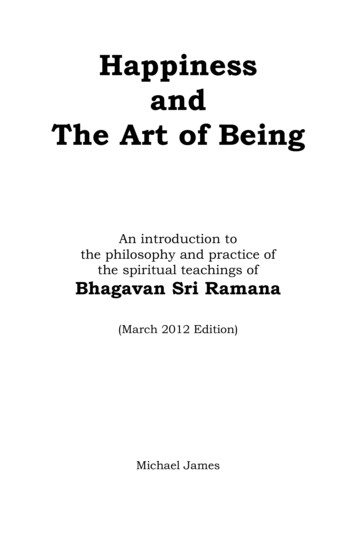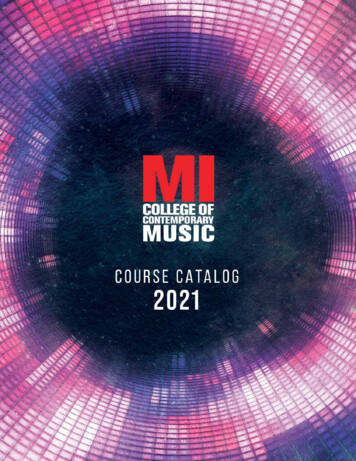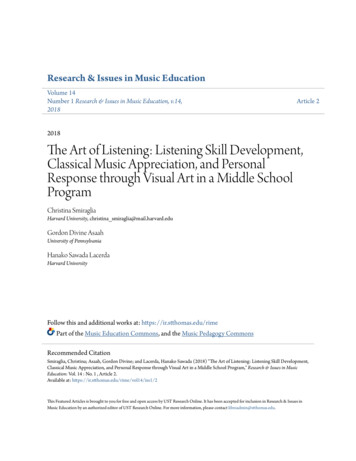
Transcription
BRIDGESMathematical Connectionsin Art, Music, and Science·Fractions in Art and MathematicsJane K. Bates, Ed. DArt EducationTowson UniversityTowson, Md 21252jbates@towson.eduAbstractArt and mathematics are two subjects in the K-12 curriculum that can be readily linked in a synergistic way: Art deals withcomposition -visual relationships of the parts to the whole; mathematics deals with numeric and geometric relationships. Thispaper presents a unit of study on the 6th - 7th grade level, which could be taught in either a mathematics or an art course, focusingon fractions as explored through visual design. It integrates understanding of fractions, skills in measuring, and creating anartwork incorporating fractions of geometric shapes and designs of numbers achieved through a stenciling process.Background on the Interdisciplinary ExperienceThe unit of study, entitled "Fractions in Art and Mathematics", was developed by two art educationstudents, Cary Fentzloff and Matt Voelker in an art education interdisciplinary field experience course atTowson University. The purpose of this course is to provide opportunities for art education students todesign and implement units of study in art that use content/processes in other subjects (such asmathematics, science, and social studies) to motivate learning in each subject area. The steps taken in thedesign and implementation of the unit were as follows:1. The two students selected mathematics as their preferred academic subject to integrate with art.2. They met with a 7th grade mathematics instructor at the field site school to determine what wasbeing presented in the mathematics curriculum and to brainstorm possible interdisciplinary links.3. The students, using a framework that included instruction in art making, art criticism, art history,and aesthetics, brainstormed ideas for the integration of mathematics skills/concepts with art.4. Fractions was selected as a theme to connect "visual composition" with "mathematicalcomposition".5. Robert Indiana, Jasper Johns, and Piet Mondrian were selected as artists exemplifYing the use ofmathematics content/processes in their work.6. Visuals, a unit plan, and lesson plans were created to lead the ? grade students throughmathematics and art making processes.7. The plans were implemented over six 45-minute sessions.8. A notebook documenting the experience was created as an example of art! mathematicsinterdisciplinary education.The unit plan that follows outlines the goals, concepts, skills, and teaching procedure that Ms. Fentzloffand Mr. Voelker developed to integrate art education with mathematics education.
182 Jane K. BatesThe Unit Plan: Fractions in Art and Math1. Theme and General Descriptiona) Fractions serve as the theme' to explore mathematics-art connections. The unit integratesunderstanding of fractions, skills in measuring, and the creation of artwork incorporating the useof nwnbers and wholes/fractions of geometric shapes.b) Grade level: middle schoolc) Time: six 45-minute sessions2. Goalsa) To develop knowledge and appreciation of mathematics concepts, skills, and use in the creationof art (historical/aesthetic domains)b) To develop knowledge and appreciation of artists Piet Mondrian, Robert Indiana, and JasperJohns, who use mathematical processes and content in the creation of their works(historical/aesthetic domains)c) To demonstrate skills in measuring and partitioning of shapes to create fractions (productivedomain)d) To demonstrate an understanding of formal qualities in art, focusing on composition achievedthrough warm and cool color schemes, positive and negative shapes, repetition, and contrast.(critical/productive domains)e) To demonstrate skills in the use of media and processes, including cut paper collage andstenciling with oil pastels (productive domain)t) To demonstrate problem-solving skills in the design of an original composition integrating art andmathematics (productive domain)g) To develop critical skills through oral and written discussions of cultural exemplars and finalproducts (critical domain)3. Concepts/SkillsArt ConceptsMath Conceptsa) Artists Robert Indiana and Jasper Johnsa) Nwnbers are used in mathematics to solveused nwnbers as subject matter in theirarithmetic problems.artwork.b) Artists Robert Indiana and Piet Mondrianb) A fraction can be used to represent theused geometric shapes to divide space.congruent parts of a whole.c) Cut paper collage is the process of cutting c) Rulers are tools used in mathematics forand gluing shapes to create 2D designs.measurement purposes.d) Stenciling is a printing process used tod) Geometric shapes can be constructedcreate repeated positive and negative shapes. through the connection of accuratelymeasured lines and line segments.e) Two color schemes are warm (red, orange,yellow) and cool (green, blue, violet).t) Repetition and contrast can be created in acomposition through choices of color and shape.g) Composition reflects the choices an artistmakes in the process of designing artwork.
Fractions in Art and Mathematics 183a)b)c)d)Art Skillsa)Cutting, gluing, arranging shapes into ab)compositionc)Experimenting with warm andcool colorsd)StencilingCreating compositions that include divisionof space (use of fractions), repetition of shapesand imagery, and color contrastMath SkillsProcess of measurement (linear)Using a ruler to construct shapesRecognizing Idemonstrating understandingof fractionsCreating fractions of a whole throughpartition of geometric shapes4. Cultural Exemplars (artworks exemplifying concepts and processes) by the following artists:a) Piet Mondrianb) Robert Indianac) Jasper Johns5. Scope And SequenceDay 1: Introduction to Interdisciplinary Art-Mathematic Connectiona) Teacher introduces unit by presenting the art of Piet Mondrian, Robert Indiana, and Jasper Johns.Teacher facilitates a discussion on the use of fractions to partition space in a composition and onthe use of numbers as subject matter in art as exemplified by these artists. (See Figures 4, 5, and6.)b) Teacher presents the concept of fractions as partitions of space using manipulative visuals(posters showing colored squares partitioned into smaller squares, rectangles and triangles,representing 1/2, 113, 114, 1/5, 118, etc. of the original square.)c) Students review artworks exemplifying use of mathematics, use of fractions to partition space,and warm and cool colors.Day 2: Creation of Collage Background Based on Fractionsa) Teacher reviews the use of fractions to partition space using the manipulative visuals. Teacherreviews concepts related to warm and cool colors.b) Teacher demonstrates how to use a ruler to accurately measure and create squares, rectangles, andtriangles that are fractions of a larger sheet of paper. Teacher provides a short cutting and gluingdemonstration.c) Students work on studio assignment: to create a cut paper design in which warm or cool coloredsquares are partitioned into fractions of the whole (1/2,114,1/8, etc.) and glued down (collaged) tocreate a background. (See Figures l(a) and 1(b).) Criteria for background is as follows:1. Choose a warm or cool color scheme.2. Use a ruler to construct accurately measured fractions of squares, making smallersquares, rectangles, and/or triangles.3. Create at least 3 definable fractions (such as 1/2, 1/3, 114, 115, 118, etc.) of shapes fromcut paper.4. Glue shapes onto 14x14 white paper background using good craftsmanship.
184 Jane K. BatesDay 3: The Stenciling Processa) Student complete collage backgrounds.b) Teacher demonstrates how to create a positive shape stencil and a negative shape stencil of anumber. (See Figures 2(a) and 2(b).)c) Students create stencil. Criteria for stencil is as follows:1. Measure 1/2 inch from top and bottom of 6x6 tag board square and make guide marks.2. Draw and cut number as a thick shape (about 1/2 inch thick).3. Tape necessary parts ofthe stencil back together.4. Keep all shapes (both positive and negative images).Day 4: Exploring Compositiona) Teacher reviews information on positive and negative shape presented on day 3.b) Students experiment with the stencil printing process, creating positive and negative images in oilpastels. They use oil pastel colors that are ofthe opposite color scheme of their backgrounds.c) The concept of composition is introduced as an artist's choice and arrangement of colors andshapes. Teacher's examples of the final assignment are shown (see Figures 3(a) and 3(b) andcriteria are established, as follows:1. You must use the stencil printing process to repeat the number on your cut paperbackground. If you have a warm colored background, you must choose cool colored oilpastels for stenciling. If you have a cool colored background, you must choose warm colored oilpastel for stenciling. You have the option of using black and white oil pastels for accents.2. You may choose to collage the stencil itself onto your composition.Day 5: Work Daya) The criteria for the final composition are reviewed.b) Students work on final products.Day 6: Final Day for Critique and Reflectiona) Students complete final products.b) Teacher and students share and discuss artwork during class critique.c) Teacher leads a review of how students used mathematics to create artworks.d) Students complete a closing written reflection sheet (see figure 7) to demonstrate learning.
Fractions in Art and Mathematics 1856. Evaluation Questionsa) Reflection on planning and teaching1. How effectively were art and mathematics concepts integrated to support the unit theme?2. How effective was the sequencing of activities to support unit content and learning ineach subject area?3. Was time sufficient to explore processes and concepts in both subject areas?4. How effective were visuals, demonstrations and teaching strategies to teach conceptsand skills in both subject areas?b) Observation of student behaviors1. Were students motivated by unit activities relating art and mathematics?2. How well did students demonstrate understanding of art and mathematics concepts andprocesses through critical discussion, studio production, reflection sheets, and critiques?c) Assessment of studio products1. How well did products fulfill criteria?2. How well did products reflect an understanding of unit concepts in both art andmathematics?3. How successful was the work in demonstrating fulfillment of unit goals?7. Assessment of Learninga) Review the artwork produced by each student and compare it to answers given on question #1 onthe Unit Reflection Sheet (to ascertain each students level of understanding of fractions).b) Evaluate level of skill in using a ruler to accurately measure and produce geometric shapes thatillustrate partitioning of larger areas.c) Evaluate artworks on use of negative-positive space, warm and cool colors, repetition andcontrast in visual design.d) Evaluate answers to questions 2 - 6 on the Unit Reflection Sheet to assess understanding of artconcepts.e) Assess comments made by students about their artwork, the experience, and use of mathematicsduring the final critique session.Figures Illustrating Processes in Creating ArtworkFigure l(a): Example 1 illustrating use offractions in a cut paper collage background.Figure 1(b): Example 2 illustrating use offractions in a cut paper collage background.
186 Jane K. BatesFigure 2(a): Example of a number createdfrom a negative shape, which can be usedas a stencil by filling in the space.Figore3(a): Example 1 of the finisheddesign incorporating stenciled numbers ontop of the collaged background.Figure 2(b): Example of a number createdfrom a positive shape, which can be used asa stencil by drawing around it.Figure 3(b): Example 2 of the finisheddesign incorporating stenciled numberson top of the collaged background.
Fractions in Art and Mathematics 187CulturallHistorical Information on ArtistsPiet MondrianFigure 4: by Piet Mondrian,illustrating partitioning of space (fractions).The Dutch painter Piet Mondrian devoted hiscareer to exploring the potential of geometricshapes in his compositions. He felt that certainthings are universal - the rectangle, the verticaland horizontal, black and white and primarycolors. Using these elements, he hoped to cutthrough cultural and emotional differences andmake a statement meaningful to all - arepresentation of "pure reality."Robert IndianaFigure 5: Decade Autoportrait. byRobert Indiana, illustrating theuse of numbers as subject matter.The American painter Robert Indiana is widelyknown for his large-scale paintings of numbersand words. He lived most of his life in NewYork, where during the 50s, 60s, and 70s hewitnessed people from around the world comingto seek the American dream. His paintingsreflect views of America during specific periodsof time.Jasper JohnsThe American painter Jasper Johns also paintedsymbols of America (such as the American flagand a map of the United States). He also createdmany compositions using letters and numbers asdesign elements.Figure 6: Figure 2, by Jasper Johns.illustrating the use of numbersas subject matter.
188 Jane K. BatesFRACTIONS IN ART -UNIT REFLECTION SHEET1. Identify the fractions you selected to illustrate in your collage background. Describe thesefractions by color and shape. (Example: 114 red triangle; 118 orange rectangle, etc.)2. Explain what stenciling techniques you used to create your artwork - use of positive shape, use ofnegative shape, etc.3.Which color scheme did you choose for your background?Which color scheme did you choose for you stenciling?4. Name one of the artists we studied in this unit and discuss how he used mathematics in his art.5. List at least two reasons why your knowledge of mathematics was important to you as an artist.(a}(b)6. Describe how your artwork uses (a) repetition and (b) contrast.(a)(b),7. Describe what you like best about your artwork.8. Describe what you liked about this unit.9. Describe what you disliked about this unit.Figure 7: Sample unit reflection sheet.References[1] Bates, J. (2000). Becoming an Art Teacher. Belmont, CA Wadsworthffhomson Learning[2] Gilbert, R. (1992). Living with Art (third edition). New York: McGraw-Hill, Inc.
3. The students, using a framework that included instruction in art making, art criticism, art history, and aesthetics, brainstormed ideas for the integration of mathematics skills/concepts with art. 4. Fractions was selected as a theme to connect










